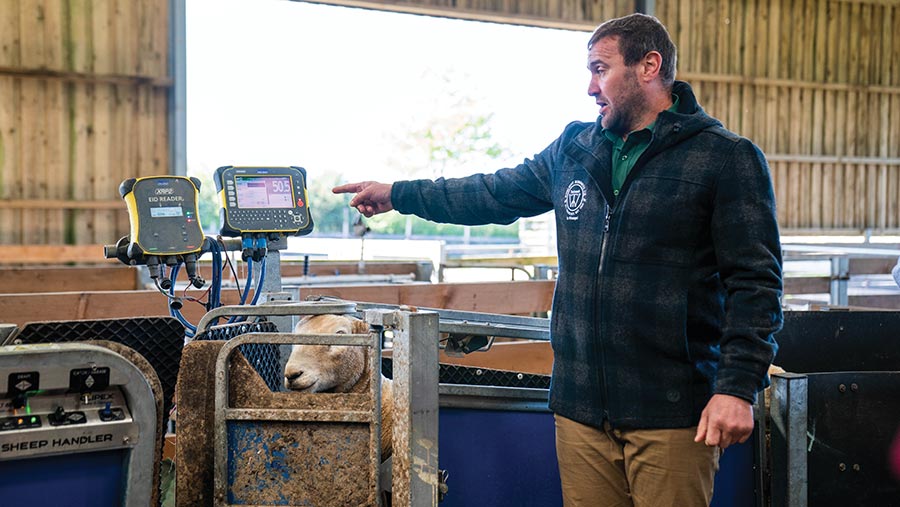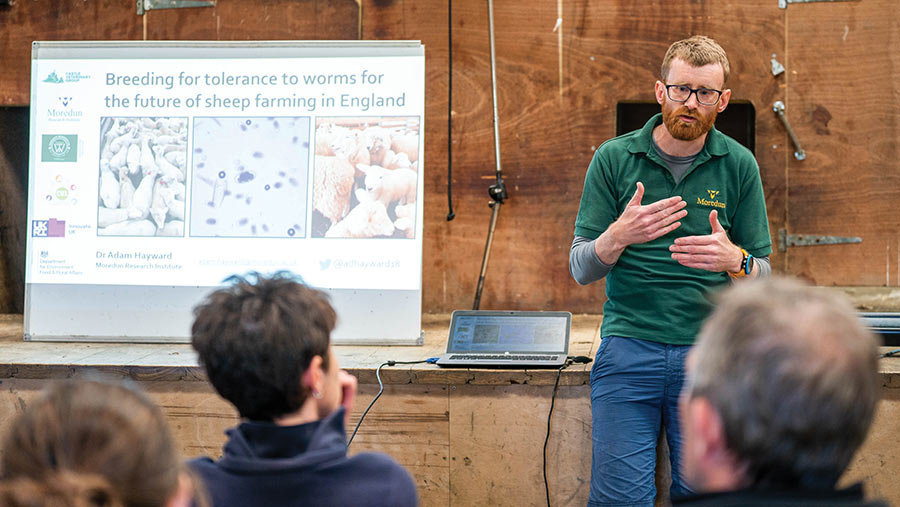Can sheep be ‘worm tolerant’ and what are the implications?
 © Emily Fleur Photography
© Emily Fleur Photography Lambs most tolerant to worm burdens could have a 10-day weight gain advantage over less tolerant ones, a pilot study has shown.
The study, Breeding for tolerance to worms for the future of sheep farming in England, was carried out in light of the fact that worm infections are estimated to cost the UK sheep industry in excess of £42m/year.
These costs arise through treatment and lost production as a result of poor growth rates. As well as the economic implications, there are also resistance concerns about the overuse of wormers.
The work was funded by the Defra Farming Innovation Programme Research Starter Competition, supported by Innovate UK, and involved four partners: Moredun Research Institute, the Centre for Innovation Excellence in Livestock (Ciel), Castle Vets and Cornish farmers Matt and Pip Smith.
The project’s aim was to see whether or not variation in worm tolerance exists in UK sheep and to consider an alternative approach where farmers breed sheep more able to tolerate gastrointestinal worm burdens.
This, in turn, could reduce reliance on anthelmintics and lower labour input, as well as enable sheep to maintain production targets.
See also Why demand is hotting up for worm-resistant rams
Tolerance v resistance
Tolerance is well documented in plant science and arable cropping, but less is known about it in livestock and how this can be exploited to better prime animals against infection and disease.
Unlike resistance, where an animal forms an immune response to infection, tolerance enables stock to perform well despite infection or parasitic burden, so it is important to understand the difference between the two, explains Dr Adam Hayward, research fellow at the Moredun Institute.
While both resistance and tolerance enable stock to manage worm burdens without treatment, resistance traits can lead to a trade-off, with growth rates dropping owing to the energy cost of the immune response.
As this response does not occur with tolerance, growth rates can be improved, which could make it a more attractive trait to select and breed for.
That said, tolerance and resilience are likely to work together and are both part of sustainable parasite control, says Adam.

Matt Smith © Emily Fleur Photography
Trial design
The trial took place at Matt and Pip’s Trefrank Farm, near Launceston, where they have focused on breeding tolerance into their 800-head Te Whangai flock of Romneys.
This is something inspired by Matt’s New Zealand heritage, where tolerance is widely discussed and Romneys, in particular, are thought to have better tolerance to worm burdens.
The study involved a group of 200 Romney ram lambs from 16 different sires, with lambs having an average age of three months at the start.
An additional 20 lambs were used as a control group and received a wormer every four weeks.
A benchmark was set that trial rams would receive no treatments unless growth rates dropped below 70% of the control group.
While resistance can be assessed with just one egg count, multiple counts are needed to make any conclusions about potential genetic tolerance.
Therefore, nine fortnightly faecal samples were collected between July and November last year and sent to the Moredun Research Institute analysis.
Lambs were then fasted overnight and weighed in the morning via an electronic identification-enabled weight crate to gather data on growth rates and compare these with egg counts.

Adam Hayward © Emily Fleur Photography
The findings
The trial was on a small scale and only based on one year’s results, so it is still in its infancy, explains Adam.
However, there were some significant headline findings. Mean daily liveweight gain across the study averaged 52g, while mean worm faecal egg count came in at 415 eggs/gram.
Statistical analysis of the combination of faecal egg count plus growth rate showed a significant difference in tolerance levels between both individual rams and lambs from different rams, which enabled researchers to grade lambs from most to least tolerant.
At the end of the study, those lambs that tolerated high worm burdens by maintaining good growth rates, without the need for treatment, were classified as most tolerant.
Worm counts varied for individual lambs, but based on the average worm count, lambs with low tolerance experienced a weight penalty of more than 500g.
This penalty was reduced to less than 50g a lamb in those with higher tolerance to worm burdens.
In some cases, Matt says he even saw some of the most tolerant lambs overtake the control group in terms of growth rates.
In practical terms, the most tolerant lambs were estimated to be 10 days ahead of the least tolerant ones in terms of weight gain.
Lambs sired by the most tolerant rams were about six days ahead in terms of growth than those sired by the least tolerant.
This variation between sires suggests there is a genetic element to tolerance, which could be optimised at farm level by breeding from more tolerant sires, says Adam.
This could reduce anthelmintic use and labour costs associated with drenching, while also improving growth rates and financial returns.
What is not clear at this stage is the heritability of tolerance, as not enough data was collected within the pilot to draw any conclusions, he adds.
Next steps
Though the pilot study is now complete under the current funding, the research partners are running various further projects to continue the exploration of tolerance.
At Moredun, this includes a study looking at the controlled infection of 30 housed lambs, with another looking at natural infection of 120 lambs on varied pasture.
“We’re particularly keen to look at this across multiple farms and multiple breeds, to understand more about the genetics,” says Adam.
Tolerance v resistance
Susceptible animals Animals that make poor immune responses to an infection and, as a consequence, have high worm faecal egg counts and poor weight gain.
Resistant animals Animals that make effective immune responses to worm infections by preventing worm establishment and/or removing them from the digestive tract. As such, they have a low faecal egg count, but this comes at the cost of poor weight gain owing to the energy required to produce an immune response.
Tolerant animals Animals that do not make an immune response to infection, so have high faecal egg counts. However, they continue to perform and grow well despite the burden. There is much still to learn about the mechanisms that enable this tolerance, but it may be down to more efficient digestion of forage or an animal’s ability to repair damage caused by worms.
Source: Moredun Research Institute
